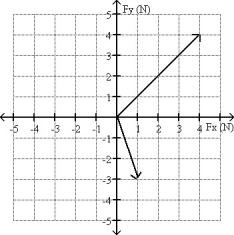Multiple Choice
FIGURE 5-2 
-The two forces indicated in Figure 5-2 act on a 3.00-kg object. What is the acceleration of the object?
A) (1.67 m/s2)  - (0.333 m/s2)
- (0.333 m/s2) 
B) (5.00 m/s2)  + (1.00 m/s2)
+ (1.00 m/s2) 
C) (1.67 m/s2)  + (2.333 m/s2)
+ (2.333 m/s2) 
D) (15.0 m/s2)  + (3.00 m/s2)
+ (3.00 m/s2) 
E) (1.67 m/s2)  + (0.333 m/s2)
+ (0.333 m/s2) 
Correct Answer:

Verified
Correct Answer:
Verified
Related Questions
Q63: Mass is a measure of how difficult
Q64: What does the word "normal" mean in
Q65: FIGURE 5-4 <img src="https://d2lvgg3v3hfg70.cloudfront.net/TB6213/.jpg" alt="FIGURE 5-4
Q66: A 40.0-kg crate is being lowered by
Q67: When a parachutist jumps from an airplane,
Q69: Three boxes rest side-by-side on a smooth,
Q70: A force of 120 N is applied
Q71: An object is being acted upon by
Q72: An object of weight W is in
Q73: The mass of a proton is 1.7